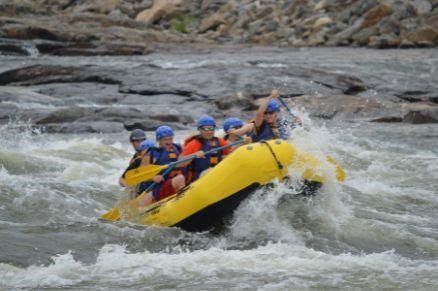General Insurance Blogs, Articles & Updates by - Magma HDI
Have us call you
- RENEW YOUR POLICY
- BUY NEW POLICY

A middle-class life on a two-wheeler: Common mistakes to avoid
Transport is the lifeline of civilization, and the role of low-cost transportation in a developing country like India is crucial. For a larger section of society in urban, semi-urban and rural areas, cars are non-affordable. Therefore, two-wheelers are an all-time favourite among the middle class who can afford something more sophisticated than a bicycle.
While two-wheelers are necessary for many, poor road conditions, unorganized and rash driving, and traffic rules violations make bikers unsafe. Therefore, it is always important to stay safe on the road, ride with proper safety gear and always wear a helmet. To get additional protection for your two-wheeler, you can purchase 2 wheeler insurance online. Insurance can be of great help to overcome the losses due to mistakes that happen on the roads.
Let's have a look at a few common mistakes to avoid while riding a two-wheeler.
1. Listening to music:
Nowadays, many helmets come equipped with a Bluetooth system, with which you can attend calls. They can also communicate with other riders during a group ride, but many people misuse this feature by listening to music through Bluetooth. Music can be distracting to severe extents. It reduces your alertness, and you compromise with your listening ability too. It is always important to have situational attentiveness when in traffic. You can listen to music on a long trip, but that too on a low volume. Be sure that you are still able to hear the faint noises of other approaching vehicles.
2. Travelling at night:
People try to cover long distances at night to avoid the harsh sun during the day, but it can be hazardous. Riding at night is way more challenging than riding in broad daylight. Naturally, the human biological clock winds down at night, thus, making you feel sleepy. So, if you are not a professional rider, it is highly unsafe for you to ride long distances at night. Try to start early in the morning and ride till midday to cover long distances instead of riding at night.
3. Carrying heavy loads:
People have a habit of using their scooters to transport goods for a short distance which can be dangerous. Not only does it deteriorate the performance of the vehicle in the long run, but also affects the braking mechanism. Riding with more than the gross axle weight compromises the vehicle's ability to stop under panic braking situations. So be sure to check out your vehicle's gross axle weight (GAW) on the manufacturing company's website.
4. Overtaking at a blind curve:
At the blind curves on the road, you can only see a few meters in front of you. In such situations, it is risky to overtake the vehicle ahead of you because you may be unaware of any vehicle approaching from the blind side of the curve.
We all have come across at least one person who has met with an accident while riding a bike. Two-wheelers are convenient and cost-effective, but they are also more prone to accidents. So, be doubly sure to have a valid insurance cover, and if you don't have one, we suggest buying a 2 wheeler insurance online. It will financially back you in case of an accident. Be cautious while riding to have safer journeys!
Planning to buy 2 wheeler insurance online? Click HERE for details.
Disclaimer: The information provided above is for illustrative purposes only. To get more details, please refer to policy wordings and prospectus before purchasing a policy.

Constructing your dream house? Make these suggestions a part of your strategy
It is our lifelong emotional dream to have a home for us. It is where we make the most memories with our families and cherish them for the rest of our lives. So, have you already decided to build your house? Congratulations to you on your decision!
But you can't imagine a piece of land as your home as it requires a lot of planning and proper construction. It is advisable to hire professionals as you will spend your life savings on this one project. In this article, we have put together some suggestions to help you design and construct your house.
1. Decide your budget:
The crucial aspect of constructing your own house is the budget. Your budget should be precise and inclusive of the expenses involved, from laying the bricks to finally stepping into your newly constructed home after completion. Remember, after building your house, you should have enough money to support a comfortable living for your family.
2. List the space requirements:
Have an idea of how many bedrooms you wish to have. What should be the appropriate size of your living room and kitchen? Will you need a separate kid's play area or a pooja room? Listing all the requirements will make the design work hassle-free, and the blueprint of your house can be accordingly finalized.
3. Hire an architect:
Find a good architect by looking at some of the portfolios online to better understand their expertise and intent. Then, make sure that the architect offers you the best suggestions for your house. An architect will,
• Make a few designs for you to select from.
• Supervise construction periodically.
• Check and certify the contractor's bills.
• Prepare structural design, Bill of Quantities (BOQ), cost estimates, drawings for approval to the authority, a tender document with T and Cs.
Always sign a formal contract with the architect specifying responsibilities and payment of the architect and associates.
4. Concept Phase:
Finalize the architectural design and appoint an interior designer if necessary. Based on the designer and finishing, you can get a better idea of the final budget.
5. Detailed design:
The structural engineers and electrical consultants will develop the designs and details based on architectural drawings. So it becomes convenient for these people to arrange for the materials and manage the required manpower. A detailed design also helps decisions regarding the flooring materials, ceramic fixtures, CP, fittings, requirements of light points, internet, ceiling fans, etc.
6. Approval from the authorities:
It is essential to obtain prior approval and sanctions for the drawings prepared by the architect. Make sufficient copies of the drawings as these will be required to get power, water, and sewage connections.
7. Tender phase:
The architect prepares a tender document to get the best prices and shares it with a few contractors. Then, you can meet the contractors to negotiate further and discuss essential points like the date of commencement and completion, terms of payment, any additional requirements, etc.
Once the construction phase gets over, the finishing stage commences. Now, collect all the documents related to the project, such as architectural, structural, and services drawings, warranties, final bills, and other necessary documents.
It feels incredible when you see the steel bars, layers of bricks glued with cement taking the shape of your house. You will feel accomplished by observing your progress because just thinking of building a house is itself a bold decision, and successfully making it is even bolder!
There is much discussion on how to construct your house, but what once it is ready? How will you ensure its security? For this, you can go on the web and search for a 'general insurance online quote' and buy the most suitable home insurance to secure your priceless possession financially.
Planning to buy a new home? Click HERE to check out a home insurance plan suitable for you.
Disclaimer: The information provided above is for illustrative purposes only. To get more details, please refer to policy wordings and prospectus before purchasing a policy.

The most common driving errors you don't know you're making
When you start driving, you don't become an expert overnight. For any perfect driver, it takes a good amount of practice every day. Also, for error-free driving, it is necessary to identify and rectify the common driving mistakes. The statistic shows that nearly 98% of the road accidents result from human errors and sheer unawareness. Here are some of the common driving errors that you might be doing ignorantly.
1. Distracted driving:
Most road accidents happen because of our distracted driving. So what are the most common reasons for distraction? Usage of mobile phones while driving tops the list. We feel an urgency to read the message or answer the call immediately that we can't resist it even while driving. But in reality, it's not always the case. We forget the fine line between urgency and emergency and end up committing this small error that can land us in massive trouble while driving.
2. Sitting position and driving posture:
Sometimes your driving pattern harms your body. Getting comfortable in your car with the correct sitting position is necessary. It might affect your back and spine. In addition, your posture can compromise your control over your vehicle, such as pushing the brakes and clutch, which can cause you some trouble.
3. Disobeying/ignoring signal lights:
Now, without getting caught by traffic police, the advancement of CCTV over the roads will burn your pockets when you break the signal. But, we still end up making those silly mistakes like ignoring the yellow/amber signal light. Yellow/amber signal lights are an indicator to "slow down", and when it turns red, you are supposed to "stop". But we prefer to "speed up" so that we don't need to stop and wait at a red light. And that's where most of the car crashing occurs.
4. Unused mirrors/indicators of your vehicle:
The rear-view and side mirrors of your car have some purpose. These mirrors are used to look for the vehicles behind you and on either side of your car.
5. Light indicators while driving:
Lights installed on your vehicle play a vital role in safety. Unfortunately, many of us don't use indicators. It can be unfortunate for you and the vehicles following your car on curvy roads or turnings. It is a good practice to use indicators so that vehicles behind you can be alert and slow down without hitting your car.
Driving with a high beam at night is prone to disaster; it is useful when driving on streets or roads without streetlights. However, it can distract and even blind the other drivers on a two-way road especially.
6. Switching lanes at turns:
Driving and switching lanes is equally dangerous. Start early, if you anticipate some traffic, so that you don't have to indulge in rash driving and over-speeding. Know that life is much more important than the destination you want to reach.
On a conclusive note, we must hold ourselves responsible for ensuring safety on roads. Therefore, practice safe driving and purchase car insurance for more safety of your car and yourself. And timely car insurance renewal is equally necessary for extended protection of your valuable possession.
Are you looking for a renewal of car insurance? Click HERE.
Disclaimer: The information provided above is for illustrative purposes only. To get more details, please refer to policy wordings and prospectus before purchasing a policy.

Visit these best places to enjoy thrilling river rafting experience in India
Considering the multitude of experiences, travellers all across the globe talk about India being their preferred destination for travel. Blessed with an extensive network of rivers flowing through the interiors of different states, India opens up to exciting river adventures for travel enthusiasts. One such adventure is river rafting, which charges up travellers' adrenaline.
This off-beat experience was introduced to boost India's inbound and domestic tourism, and over the years, it has shown remarkable responses from travellers. Manoeuvering the raft, feeling the roaring waters gushing past, and trusting the fellow rafters is a lifetime experience. Following is the list of places where you can plan to enjoy river rafting.
1. The Ganges, Rishikesh:
Rishikesh is a traveller’s favourite river rafting destination in India. Rafting in Ganga promises you a vast arena of difficulty levels and routes. No matter the level of expertise, you get to experience river rafting for everyone here.
Another benefit of choosing this stretch is the breathtaking views. The Garhwal mountains and the white sand river beaches are some of the most beautiful sites you wouldn’t want to miss out on. Plan to visit this place between September and June.
2. Barapole, Coorg:
This river in the southern part of Karnataka circles the Deccan Plateau and is one of the best river rafting fronts in South India. However, the route here is not for the faint-hearted as it is incredibly challenging and covers a stretch of about one hundred and fifty kilometres. July to September is the best time to visit Coorg.
3. Spiti, Himachal:
This stretch of one hundred and eighty kilometres spans between the Tuting region and reaches up to Pasighat. Rafting is spread over six days. What makes it worth the experience is the scenic views of villages and a closer look at the local life of the area. Tourists throng the place during July and August.
4. Kundalika, Maharashtra:
Kundalika is considered to be one of the fastest flowing rivers. River rafting here is open throughout the year. Kundalika is close to Pune and Mumbai, making it ideal for weekend getaways with family and friends. The green views and the rich rice fields are sure to be an experience and worth remembering.
5. Beas, Kullu Manali:
A relatively short route between Pirdi and Jhiri, the river rafting here covers a distance of about 14 kilometres. However, the rapids here can be challenging to manoeuver, but the scenery of the Beas makes it a must-visit place when in Kullu. The rafting is open between July and September.
6. Indus, Ladakh:
Indus hosts many river rafting spots, all of which are open for beginners. It offers spectacular courses and locations such as the Grand Canyon of Asia or the Zanskar canyon, the beautiful Ladakh skies, etc. The best season starts from July and goes on up to September.
Now that you have seen the list of places that host spectacular river rafting experiences in the country, get ready to plan your next trip to these places to feel the thrill. Whether going with family or friends or travelling solo, always keep safety your priority. Follow all the instructions carefully and make the optimum use of the safety gears provided to you. A little negligence can be fatal, and don't let carelessness spoil all your fun.
Take that extra mile towards safety and look for general insurance online quote to add value to your trips. Stay protected against all the additional costs you might face during your journey and are compensated for any damage or loss to your luggage. Ensure a safe touring experience with Magma HDI's insurance coverage.
Click HERE to know more about general insurance online quote.
Disclaimer: The information provided above is for illustrative purposes only. To get more details, please refer to policy wordings and prospectus before purchasing a policy.


